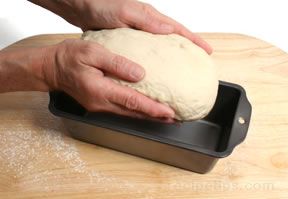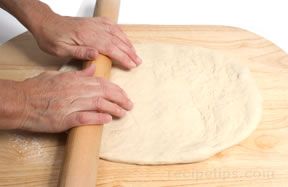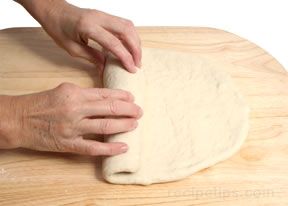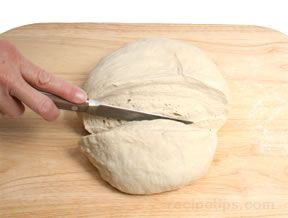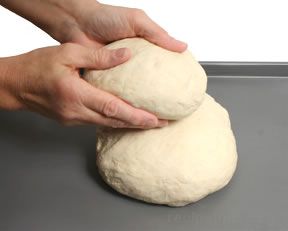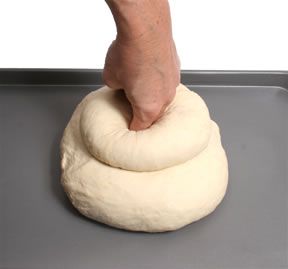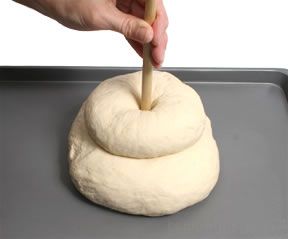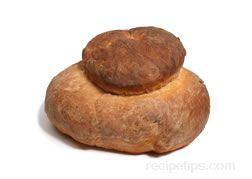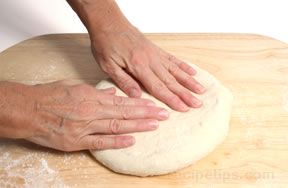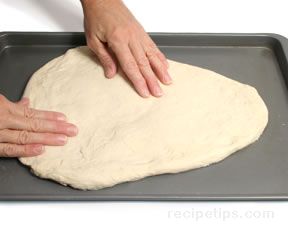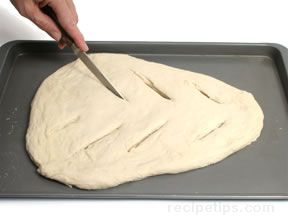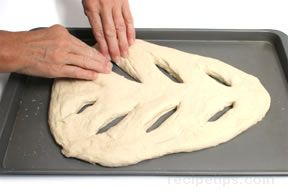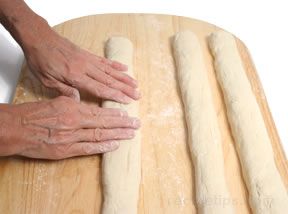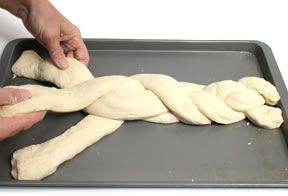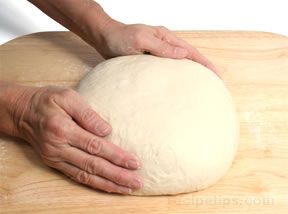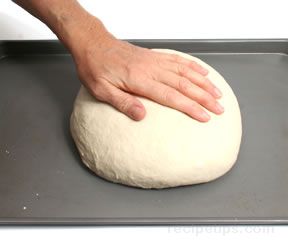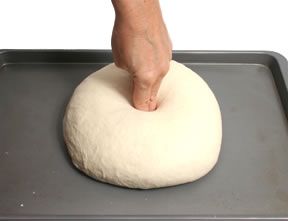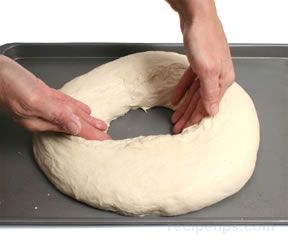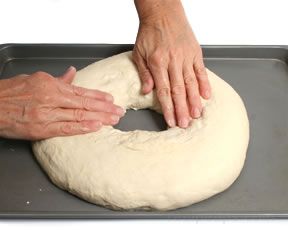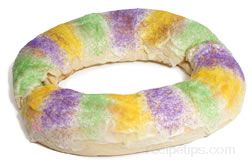Standard Loaf Pan | Bloomer | Cob or Boule | Coburg | Cottage
Molded Tin or Split Pan | Baguette | Épi | Fougasse | Braided | Ring | Flat Breads
|
After the dough has been punched down, kneaded, and then has rested briefly, it is ready to be shaped. (It is important to remember that some breads may require two or more cycles of rising and punching before the dough is shaped and allowed to rise for the final time, so always follow the recipe instructions.) There are numerous varieties of bread shapes baked in containers or on a flat surface (see "Bread Shapes"). When shaping the dough, it is important to handle it carefully and not overwork the dough. Shape and work the dough on a floured surface and after shaping, allow it to rise a final time.
Some breads are slashed, which not only creates a decorative effect, but provides a means for some of the carbon dioxide gas to escape resulting in a loaf that retains an even shape. Slashing also prevents the bread from splitting and cracking while baking. To ensure proper results, always follow the instructions on the particular bread recipe for the exact requirements for shaping and slashing the dough and for the correct time for the final rising (proofing) period. |
Standard Loaf Pan
Bloomer
|
Bloomer refers to a bread shape that is cylindrical, with slightly tapered ends, but flat on the bottom with several diagonal slashes across the top. |
| To create a bloomer, roll out the dough (with a rolling pin) into the shape of rectangle with rounded corners. The longest dimension of the dough should be about 14 inches and the dough should be about 1 to 1½ inches thick. |

|
| Starting from one of the sides with the longest dimension, roll up the dough so that the final width of the loaf is about 4 or 5 inches. The ends should be tucked and smoothed. |
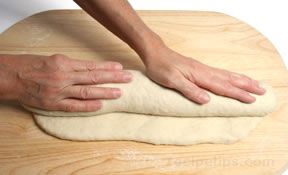 |
| Place the dough onto a lightly greased baking sheet, cover with a kitchen towel, and allow the dough to rise for the final time. Cut diagonal slashes across the top about 1½ inches apart (usually about 6 slashes) before placing the dough into the oven. |
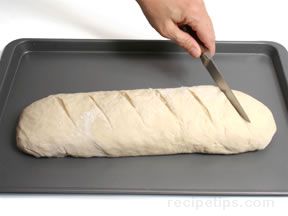 |
Cob or Boule
|
Cob is a term that usually describes rounded loaves in Britain, while boule is a term that describes similar bread shapes in France. |
| Rounded loaves are fairly easy to create: simply push the dough into a rounded form, push down gently into the center of the dough, and then flip the dough over to the other side. |
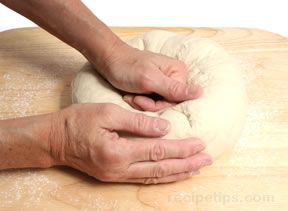
|
| With both hands cupped over the dough, rotate the dough in small increments while further shaping and smoothing the surface. |
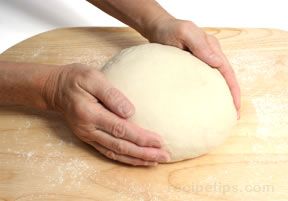
|
| Cob or boule shape after baking. |
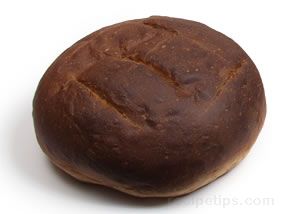 |
Coburg
|
A Coburg is similar to a cob except that it has a cross slashed into the top. |
| Create a cob shape, place the dough onto a lightly greased baking sheet, cover with a kitchen towel, and allow the dough to rise for the final time. Slash the dough down the center creating a deep score that divides the dough into halves. |
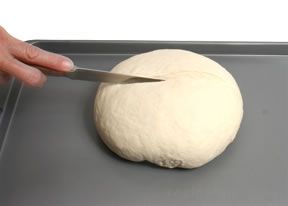
|
| Slash the dough again perpendicular to the first score, dividing the dough into quarters and then bake. |
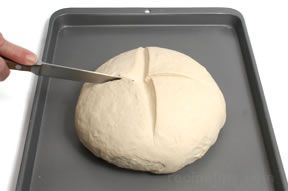 |
Cottage
Molded Tin or Split Pan
|
A molded tin refers to a rectangular bread shape that has the appearance of being split down the length of the loaf. |
| One method for creating the shape is to use two portions of dough that are placed next to each other in the bread pan. The two pieces of dough should each be about half the width of the bread pan. Smooth the tops of the halves into a rounded form and then allow the dough to rise for the final time. When baked, the halves appear to be two very narrow rectangular loaves that are joined together. |
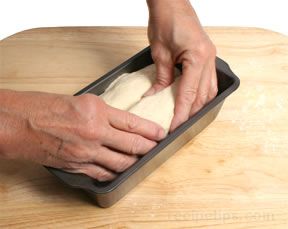 |
| A simpler method of creating the loaf is to use one piece of dough that is rounded on the top and then cut a deep slash down the length of the dough. When baked, the bread will have the appearance of two halves. |
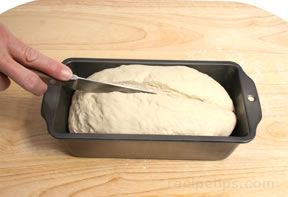 |
Baguette
|
Baguette, which is the French term for "stick" or "little rod," is a long rounded shape that has become a popular name for a number of breads with a similar shape. A French baguette can be up to 2 feet in length, 2 to 4 inches in diameter, and weigh 9 ounces or more. |
| The baguette shape is created by first flattening the dough with the palms of your hands on a floured surface or by gently flattening the dough with a rolling pin. |

|
| While grasping the dough along the longest dimension, fold the dough into thirds (the two sides folded toward the center) similar to folding a sheet of paper to fit into an envelope. |
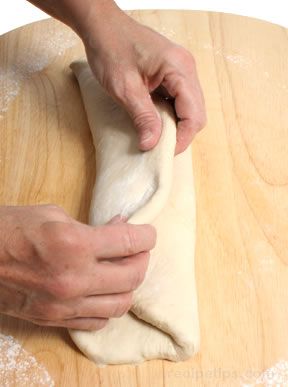 |
| Using your fingers, push into the center of the dough along its entire length to create a long cavity. |
 |
| Close the cavity by bringing the front half of the dough up and over the cavity and onto the top of the other half of the dough and then seal the seam. |
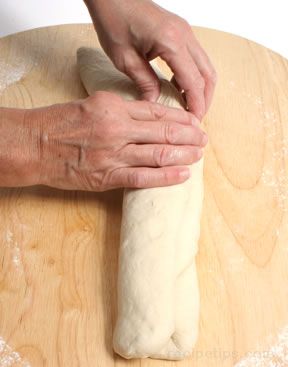 |
| With the seam side down, roll the dough back and forth with your hands. Begin in the center and while rolling the dough, move your hands outward along the length of the dough in order to gently stretch the dough to the desired length. Make sure the diameter is consistent along the length of the dough and then smooth the ends of the dough before the final rising. |
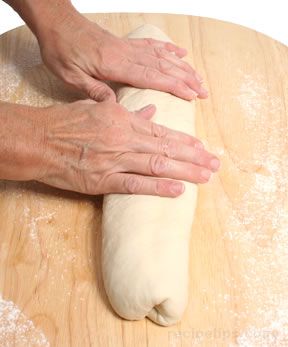 |
| Transfer the dough to a baking sheet or a baguette tray, straighten and smooth the dough, cover with a kitchen towel, and allow the dough to rise for the final time. |
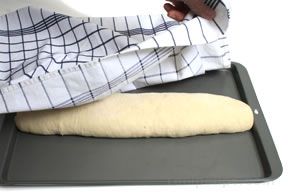 |
| Before placing the dough into the oven, slash the dough diagonally every 2 or 3 inches along the length of the dough. |
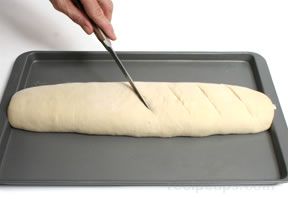 |
Épi
|
Épi is a French bread shape that resembles an ear of wheat and is quite easy to make. |
| The shape is formed by first creating a baguette shape, but without the diagonal slashes. Place the dough onto a lightly greased baking sheet. |
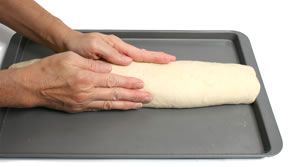
|
| Use a scissors to cut into the top side of the dough every 2 to 2½ inches along the length of the baguette. The diagonal cuts should penetrate the dough about three-fourths of the way to the bottom. The cuts create flaps in the top side of the dough. |
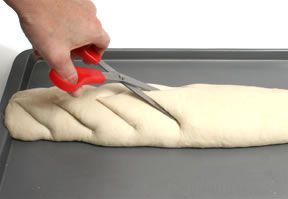
|
| Push the flaps to the sides of the baguette, alternating sides with each flap of dough. Cover the dough with a kitchen towel and allow it to rise for the final time. When baked, the flaps form individual servings along the length of the bread, which can be easily broken off when the bread is served. |
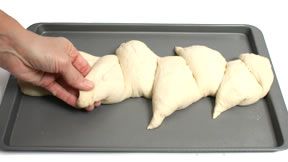 |
| Épi after baking. |
 |
Fougasse
Braided
Ring
|
A ring shape can be used for a variety of bread recipes and is easy to create. It is often used for several types of holiday breads, especially at Christmas and Easter. |
Flat Breads
|
Flat breads come in many shapes, thicknesses, and sizes. Thicker flat breads, such as focaccia are usually leavened while thin, pancake-like flat breads, such as chapatis, are often unleavened. Many flat breads have a rounded shape, while others may have a freeform shape or even a triangular shape, such as parathas. |
| Many varieties of leavened flat breads can be formed simply by flattening the dough with your hands or with a rolling pin. |
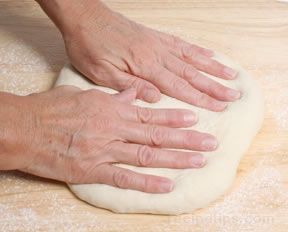 |
| Some flat breads, such as the Italian carta di musica or "music paper" bread, are very flat so a rolling pin is required when shaping the dough. |
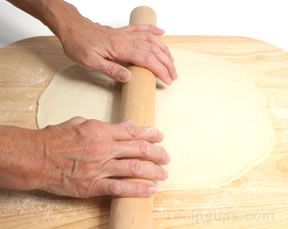
| |


